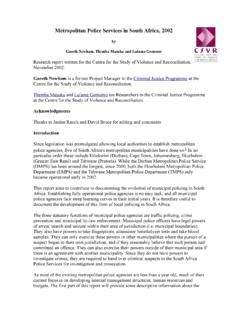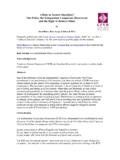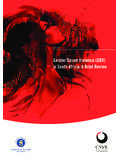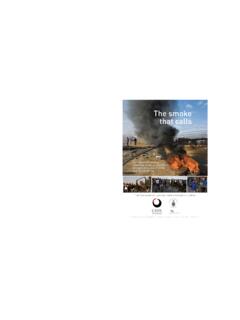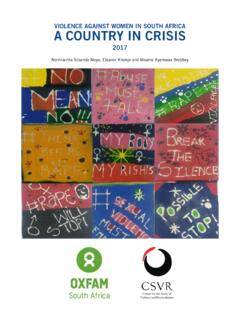Transcription of Xenophobia: A new pathology for a new South …
1 Xenophobia: a new pathology for a new South Africa?byBronwyn HarrisIn Hook, D. & Eagle, G. (eds) Psychopathology and Social Prejudice, pp. 169-184, Cape Town: University of Cape Town Press, Harris is a former Project Manager at the Centre for the Study of Violence and 1994, South Africa became a new nation. Born out of democratic elections and inaugurated as the 'Rainbow Nation' by Nelson Mandela, this 'new South Africa' represents a fundamental shift in the social, political and geographical landscapes of the past.
2 Unity has replaced segregation, equality has replaced legislated racism and democracy has replaced apartheid, at least in terms of the law. Despite the transition from authoritarian rule to democracy, prejudice and violence continue to mark contemporary South Africa. Indeed, the shift in political power has brought about a range of new discriminatory practices and victims. One such victim is 'The Foreigner'. Emergent alongside a new-nation discourse, The Foreigner stands at a site where identity, racism and violent practice are reproduced.
3 This paper interrogates the high levels of violence that are currently directed at foreigners, particularly African foreigners, in South Africa. It explores the term ' xenophobia ' and various hypotheses about its causes. It also explores the ways in which xenophobia itself is depicted in the country. Portrayed as negative, abnormal and the antithesis of a healthy, normally functioning individual or society, xenophobia is read here as a new pathology for a 'new South Africa'. This chapter attempts to deconstruct such a representation by suggesting that xenophobia is implicit to the technologies of nation-building and is part of South Africa's culture of chapter will provide a brief history and critique of the ways in which xenophobia has been understood in South Africa.
4 Building on these understandings, it will contextualise xenophobia as a current and arguably socially located phenomenon, one which is framed as pathological. It is important to mention that, within the chapter, xenophobia is not understood as a typical form of psychopathology. This is because psychopathology is usually constituted as an individual rather than social difficulty and is usually located in terms of disjuncture with society rather than vice versa. Both of these premises are contestable in an examination of xenophobia .
5 Despite this, there is political value in framing xenophobia as a pathology , even if it is not properly psychological ( psychopathological), because it allows for critical reflection on the discursive tropes that construct pyshopathology and the implications that these have at a social, as well as, individual : A Violent PracticeIn the dictionary, the term ' xenophobia ' is defined as a 'hatred or fear of foreigners' ( South African Pocket Oxford Dictionary of Current English, 1994). More commonly, the term is used to denote a 'dislike of foreigners'.
6 In this understanding, xenophobia is characterised by a negative attitude towards foreigners, a dislike, a fear, or a hatred. By framing xenophobia as an attitude, however, there is no comment on the consequences or effects of such a mind-set. This is misleading, because xenophobia in South Africa is not restricted to a fear or dislike of foreigners. Rather, as the following interview extracts reveal, it results in 'intense tension and violence by South Africans towards immigrants' (Tshitereke, 1999: 4).
7 A man from the Congo was attacked and he cried but no-one helped him. And after the thief had gone, the people on the sides said that 'because you are crying in English, we didn't help you. If you are crying in Zulu, we will help you'. Then he went to the police and was told that 'you are not our brother, we can't help you' (Focus Group with foreign students, 25/10/1999).Four guys put a gun to my head and told me to get in the car. They told me that makwerekwere1 have got bucks and that I must give them money.
8 They took my three hundred rand and those shoes I bought. And then they were beating me. And one stabbed me here [points to scar on left side of the abdomen]. Then they told me that they would let me live on one condition: 'each and every month we gonna come and fetch three hundred rand ..' I went to the police but they didn't even ask me questions. They just took my refugee papers and tore them up. Then they arrested me, saying that I'm illegal in the country, that I don't have a paper. They put me in jail for the weekend.
9 They told my friends to bring money so that I can be freed .. And those men came every month for the money. They threatened me that they would kill me and I did it for three years (interview with Rwandan refugee, 30/11/1999).Kollapan (1999) warns that xenophobia cannot be separated from violence and physical abuse. In this sense, a rewriting of the dictionary definition of xenophobia is necessary. ' xenophobia ' as a term must be reframed to incorporate practice. It is not just an attitude: it is an activity.
10 It is not just a dislike or fear of foreigners: it is a violent practice that results in bodily harm and damage. More particularly, the violent practice that comprises xenophobia must be further refined to include its specific target, because, in South Africa, not all foreigners are uniformly victimised. Rather, black foreigners, particularly those from Africa, comprise the majority of victims. It is also important to explore why 'the unknown' represented by (largely black) foreigners should necessarily invite repugnance, fear or aggression.
